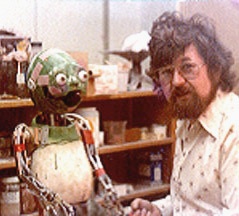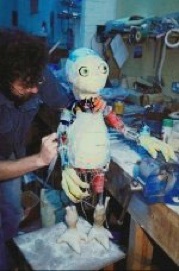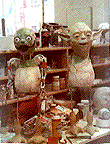CineSecrets.com


Star Wars memoirs
from someone who was actually there!
Nick Maley’s


The second file in my series about creating Yoda. You should read part one before this.
The making of Yoda part I concentrated upon background information about the design, the principle people involved and the construction of the first puppet. Part II relates to several other versions of Yoda that were made to suit specific shots and circumstances.
Because it had been decided that Yoda would be a puppet built on Frank Oz’s arm, George became concerned that we would never see Yoda’s legs and that would give away the illusion. So he asked Stuart (Freeborn) for a WALKING version.
The making of Yoda part II
1/10/15


Two mechanisms were built. One was a back-up and stood by incase the first on got damaged during filming. In fact only one was needed. People often look at the photos and think they were fully mechanical robots. But we only had 64k computers in those days. Robotics were sci fi in those days. The arms and legs were static and could be wired into any position to suit the shot. The eyes, eyelids, jaw and neck were radio controlled and the whole thing was self contained. It fitted perfectly in Luke's backpack. Mark could move freely while the operator was across the set somewhere.
I had made the molds that the skull came from. I made the skins and fitted them to the mechanisms. The hair was punched in (as it was on all the Yoda puppets) by Graham Freeborn and myself and then it was artworked.
Stu was very caught up building the intricate brass mechanism for the prototype puppet. Graham, (his son), and Kathy, (his wife), were working full time on set and that left me as the only experienced tech in the workshop. Stu considered the complexity of building a mechanical figure that appeared to walk, and told George it was impossible in the time.
Bruce Sharman the Production Manager came to me and asked if I could suggest a solution. It was clear that Stu was right... a mechanical figure was not an option but I had another idea. Because nobody knew how tall the trees on Degobah were, then IF you saw Yoda walking alone, he could be bigger than the puppet version. (If a larger version was with Luke you would see the difference immediately). So I suggested that we make a version of Yoda with a little person inside... and he would just walk through the swamp at the end of the scene when Luke meets the Jedi master.
As Kenny Baker was the smallest little person in the cast, it was suggested that he might be in the suit. But Kenny is a dwarf with a distinctive waddling walk that Stu thought was wrong for the character so instead we used a midget named Deep Roy who is small but in proportion with normal people.
TECHNICAL STUFF: The Wardrobe department made a costume to fit Roy and I quickly made a Yoda head by taking one of the skins for the puppet and expanding it with Di-iso-Octyl Phthalate suspended in Iso-proyl alcohol. (To be an effects make-up artist you have to be a chemist too). At that time we were using Windsor Hills foam and that was very sensitive to many materials..... so chemical expansion was a quick solution to the problem. Punching the hair into an ultra weak skin was very tricky but fortunately the figure was a long way away. Artworking the rather oily skin was difficult too.
There was a forth puppet that was built for ESB and I’ll tell you about that in the Making of Yoda Part III!
If you were looking for something truly unique? Found it you have!


